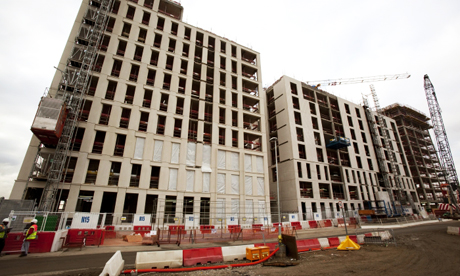Leaked report reveals concerns over accident risks at athletes’ village

Construction in progress on one of the residential blocks in the Olympic Village (October 2009). Photo: ODA
A leaked report compiled by the body responsible for delivering the 2012 Olympics has revealed serious concerns about health and safety at the athletes’ village construction site.
Workers on the site were 66% more likely to be involved in a reportable accident than those working on the Olympic Park according to the Olympic Delivery Authority (ODA) report. The internal document also reveals that the ODA was so worried about accidents at the athletes’ village that it commissioned a special review.
“Following a number of serious incidents and near misses at the athletes’ village, a review was commissioned by the ODA Director of Construction to be conducted in mid-September by the ODA Head of Health and Safety,” the report says. ‘”it is likely that the focus on the village will continue for the foreseeable future.”
The accident frequency rate for the athletes’ village for the 12 months to September 2010 was 0.25 for every million man hours worked – or eight accidents – compared to just 0.15 or four accidents for the Olympic Park according to the report. This does not include minor accidents which are non-reportable.
However, new ODA figures leaked to the Guardian show that since September workers on the village site have been more than twice as likely to be involved in a reportable accident than their counterparts on the Olympic Park. In the final three months of 2010, the accident frequency rate at the village reached 0.24 per million man hours, more than double the Olympic Park rate of 0.11.
Accounts of accidents include one where an air ambulance was called after a worker fell through a sixth floor grating to the floor below. ‘Paramedics along with the doctors from the Air Ambulance treated the casualty,’ the report says.
Another worker was hospitalised after he ‘fell from a height’, breaking his wrist and dislocating his elbow. This incident led to an investigation by the Health and Safety Executive. One ‘fall incident’ was of such concern that the ODA issued a ‘Safety Alert’ to contractors.
UCATT, the construction workers’ union which first received the leaked report, blames weaker employment rules for the higher frequency of accidents. “The Olympic Park is governed by strict rules arranged between the Olympic Delivery Authority and the unions that ensure workers are employed directly and that minimum construction wage rates are guaranteed,” says UCATT general secretary Alan Ritchie. “The same rules do not apply to the village, creating a more casualised labour environment which impacts safety.”
UCATT points to lower wage levels as evidence of casualised working. “The latest ODA workforce survey shows that 82% of workers on the Olympic Park say they are receiving hourly pay above the London Living Wage of £7.85 per hour,” Ritchie says, “but only 60% of the workforce at the athletes’ village say they are paid above this rate. This demonstrates a clear link between casualised working practices and accidents in the construction industry.”
According to ODA 32% of workers at the village who took part in the survey declined to say how much they were paid, leaving 8% who said they were not receiving the London Living Wage.
Lawrence Waterman, ODA’s head of health and safety, said in a statement: “We take health and safety extremely seriously on the Olympic Park and village, which is why we have an accident frequency rate far lower than the industry average on both sites. In fact, the village’s accident frequency rate is 65% less than the industry average.
“However, we are not complacent and constantly seeking to further minimise the risk of any incidents. We do this in partnership with the contractors and this is monitored by the regulatory bodies including the Health and Safety Executive.”
guardian.co.uk © Guardian News & Media Limited 2010
Published via the Guardian News Feed plugin for WordPress.
